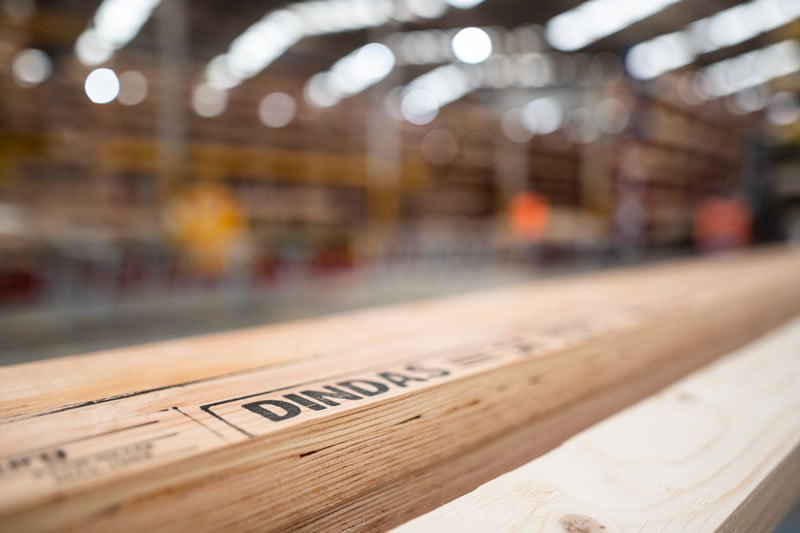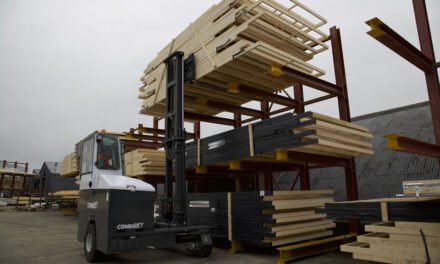It’s been a challenging year for the EWP sector, but thanks to strong products, good communication and resilient design services, industry leaders are continuing to deliver.
The process of writing a feature article involves stitching long conversations – usually held separately unless you’re lucky enough to be at a conference or online event – into a coherent whole. But sometimes, when writing out each transcript, it’s as though the far-flung participants have started to converse with each other.
Two interviewees for this story neatly state both sides of the current state of engineered wood products supply in Australia. Leon Quinn, national sales and marketing manager at Tilling Timber, says, “The leading distributors are all very good at what we do, but we’re all in the same boat: we have supply chain issues that we’ve never faced before, at the same time as having a boom in demand that is coming from across the sector and across the country.”
But there’s an upside to this, as explained by John Cannard, chief technical officer at Dindas Australia: “There’s been a change in the mindset in our customers. They have a new-found respect for the timber products they’ve been using in previous years.”
TTN has covered what EWP are and why they’re so valuable at length, so let’s just focus on two facts. Whether high-end CLT and glulam, everyday LVL, OSB and ply, or prosaic flooring boards, they all get the best combination of strength and value out of the fibre they use. And the best-known products come with reliable, repeatable qualities backed by reputable testing and brands.
The questions are: what’s going on with supply, when will things get back to normal, and what’s next in the sector? What follows are the most probable answers.
Supply issues
“Is it a cliché to call it a perfect storm?” asks Gavin Matthew, CEO at the Engineered Wood Products Association of Australasia (EWPAA).
Perhaps, but he’s not wrong. Multiple factors have coincided to bring about the current problems in supply, in ways that are unlikely to ever be repeated.
The Black Summer fires removed 130,000ha of commercial plantations, as well as destroying nearly 3000 homes. Covid hit long before most of those homes were rebuilt and while some of its impacts were foreseeable, some weren’t. The disease taking a toll on workplaces was expected, with positive cases closing or slowing manufacture and lockdowns affecting construction in some areas. But then there was the sugar hit of HomeBuilder.
“With Covid, we were preparing for a major decrease in construction,” says Matthew. “We expected a valley in demand and instead we got a big hill.”
People who kept their jobs mostly had fewer expenses, so had a lot of cash for extensions, home offices and more. Quinn says, “How we think about our homes has changed. I can’t tell you how permanent it is, but there’s a massive shift to detached housing and therefore light timber framing.”
Ours wasn’t the only booming housing market. For many months the US was out-competing most of the world for wood (especially LVL) and driving up prices. Just as that distortion began to ease a little, the full impact of the disruptions to global shipping became apparent. Quinn describes the impact on importers: “In September last year, we were paying US$1400 to move a container from Europe to here, now it’s $13,000. It’s $11,000 just to bring a container here from China. And it’s well over $13,000 ex the US West Coast as well, but they have other issues with a big log jam at their ports.
“Add to that, all the containers are in the wrong places, so a manufacturer has to compete just to get empty containers or a place on a boat. Nothing is working properly.”
Quinn notes that the pressures on builders to deliver are intense: “Those huge shipping costs haven’t slowed demand, because builders are also under huge pressure from their clients to deliver on projects.”
Australian-produced product hasn’t escaped. “We buy all our glulam from local producers,” says Cannard. “Not having the wood fibre has had an immediate effect on the amount of glulam they can manufacture and then sell. Transport-wise, staying within the state has been a lot easier than trying to cross the borders. We service Northern NSW out of Queensland as opposed to trekking from our Sydney branch is and it was a lot of effort for our truck drivers to get their permits to cross the border and be able to come back without quarantining.”
Every part of the problem has also had knock-on effects. The good news is that most people along the supply chain have understood at least part of the reasons behind delays. The better news is that distributors and merchants have kept – and will continue to keep – building going.
Strategies and Substitutions
“We’ve been playing the game all this year of substituting other sizes and encouraging whatever will keep the building sites moving,” says Quinn. “Because there are so many types, sizes and lengths of EWP, there are too many for a merchant to stock. So, historically, all of us – importers and those who buy locally – have operated on just-in-time models, with the importers holding large inventories, which have been eaten down to nothing over the past 12 months.”
What the distributors still have are their service and design teams. Crucially, they’re able to design to what product is available, and thus guarantee a solution that can be built. “In some cases, builders received a design six months ago,” says Quinn, “so when they go to order it now, we’re redesigning to what stock we have so they get matching documentation for that product.”
At Dindas, Cannard and his team focused on communication. “It’s the thing I’m probably most proud of out of what we did as a business,” he says. “We gave them the model we were going to work to and while that wasn’t ideal, it was what it was with 100% transparency and they still ended up getting product. We looked after our customers first and foremost, as opposed to taking on new business. We found that, more often than not, when they know our plan, they can create their own plan and work to that.”
The experience has changed processes at Dindas but, says Cannard, it’s also changed the builders: “We run a zero waste facility in all three states we provide our engineered wood products in. In the past, that was much less of a focus for the builders. Now we’ve seen a change in the mindset, it’s as if they’re literally throwing out gold bars when they’re putting timber in the waste basket. So we’re seeing a lot of the bigger builders really tuned in to finding efficiencies on site to minimise waste.
“It gives them an insight on why we make design choices from a performance and efficiency aspect and they’re really jumping on board with it.”
Certified quality
Compliance and consistency are where EWP can shine, says Matthew. Certified EWP sold in the Australian market has known and tested qualities and reputable Australasian producers and distributors, including Dindas, Hyne, Meyer, Tilling and Wesbeam, provide detailed product and application information to support the market and customers.
“It supports the work done by engineers, designers and architects,” he says. “The way we build continues to change, whether that’s using glulam for large spans, endless variations in frames and trusses or using renewable timber solutions to build multi-storey commercial and residential buildings.
“What you get with EWP is its strength, reliability and renewable product solutions. But this is a challenging time for potentially non-compliant product being supplied into this Covid-disrupted and high-demand market. You need to do your due diligence, look at the branding and underlying compliance pathways of any product supplied and make sure they make sense. And if they don’t, you should be wary of it and ask more questions.”
The major brands have an extensive record of testing and are very open with their product information. “It’s funny, but the layers of compliance and warranty, which we’ve always had, are probably the most bankable thing about what we’re doing for the market right now,” says Quinn.
“We have wonderful new products lined up for when the supply starts to sort itself out – and we expect we’ll be working on this for the rest of this year and through 2022 – but right now the strongest thing we offer our customers is the security that we will get them certifiable product.
“Ironically, that can make Australia a less attractive market, because our international suppliers can sell into markets that will take lower-quality product. We balance that with things like bringing payment terms forward.”
Dindas also has a major piece of news waiting. In the meantime, 2021 has validated the company’s decision to invest in what they call their RAD Lab – a research and development facility in Queensland that works in partnership with local universities and manufacturers and “is primarily used to test all the different ways that we can use a product,” Cannard says.
“It’s also a continuous process of learning for us; to see where can we do better, what’s missing from our supply side that would fix the builders’ problems on site or give them a solution to an ongoing issue that might not be available on the market.”
He gives an example: “We might look at a particular type of LVL and say ‘This typically has five uses in the industry, how can we turn that into 10? And will they work? We have some harebrained ideas that simply don’t work but you don’t know that until you put them into practice. We’ve had builders jump on board and come into the RAD Lab and work with us on issues – I’d love to tell the world what we do, because it’s super exciting, but sometimes you have to keep the advantage behind locked doors. It’s a certified lab, so any of the results we develop are fully compliant.”
Innovation and investment
Happily, there is good news that is ready to be shared. “We’ve just installed a Combilift-CSS at our Kilsyth site,” says Quinn. “It’s the first one in Australia and it’s being tested as we speak. Right now, we’re looking forward to it unloading containers in 10 minutes, which will help us get product out almost as quickly as it comes in.
“In the future, we’ll have one each in Sydney and Brisbane. It’s a piece of control that we can put back in the process; we’re making that investment to shorten the time for product to come off the wharf.”
At Dindas, a recent website revamp was informed by the team’s work with builders. Cannard says, “We’ve created a full interactive 3D environment online where a builder can go and click on a detail and spin it around in 3D and it gives him step-by-step notations as to how to fix things including watch points, like ‘nail from the inside to create a bigger edge distance and reduce the risk of joist splitting’. The uptake from our customers on that has been unreal!”
The Dindas 3D Connection Library is uploaded as PDFs, to minimise the number of file extensions on the web, but “with the modelling software we have, there’s the ability to export straight into most of the common CAD programs,” says Cannard. “Typically a builder will ring me and say ‘I love this detail, can we drop it into our CAD program?’ and I’ll just send them an individual CAD file.”
All these details are also accessible by QR code on the Dindas site layouts, which means they’re only a smartphone away when questions arise on site.
“Currently, we’re the only ones that have this level of software in Australia, and we’re pretty proud of our developments,” Cannard says. “There’s a high level of detail that goes to site for the builder, including three layouts of the plan view of the house. The first one’s basic, easy-to-read joist information. The next one’s the beam information. And then there’s our colour-coded green and yellow on heat performance mapping, which gives them an indication of how well in what areas their floor is performing to standards. So we can sit down in front of our customer and honestly show them the expectations of how their floor performs.”
More broadly, the building EWP sectors in Australia are changing, partly in response to the challenges of the past 18 months and partly in continuation of pre-existing trends.
“One trend that started a while ago, but has recently been highlighted by distributors, is increased innovation in combining EWP (eg hybrid products, LVL and panel products, box beams and I-beams and the like) to create bigger end-sections and substitutes into timber designs,” says Matthew. “While some of that innovation is driven by what’s available right now, there are new product solutions coming out of it that will continue.”
Matthew is also enthused about the growth of new EWP manufacture in Australia. “Hyne’s new glulam plant at Maryborough is gearing up to supply product to the Australian market,” he says. “There’s a combined CLT/glulam plant announced by Timberlink to be built in SA. New investments are being made in timber panel production around Australia, and CUSP is developing CLT and glulam products from hardwood plantation timber in Tasmania. For EWP that have a high demand here, it makes sense to invest in capacity.”
At the other end of the chain, there are more mass timber builds in the Australian market, “and not always at the big end,” Matthew notes, pointing to CLT and glulam-based designs in regional areas for both private residences and small public buildings, where the quick build times and high finishes allowed by the product mitigate some of the challenges of remote building.
“As these new manufacturing investments in glulam and CLT gear up and start to produce, I think they can and will do a span of product from big to small and bespoke,” says Matthew. “The supporting standards, codes and acceptance of the compliance pathways of these new products into different construction uses will progress quickly as well. Right now, the new products need expertise and engineering knowledge behind them to get into the market. But once their use becomes more commonplace, then compliance pathways including deemed to satisfy are formalised, giving designers and builders increased ease of use.”
Apart from ongoing certification and testing activities, EWPAA is focused on three strands of industry advocacy. The first is delivering feedback to Safe Work Australia’s review of workplace exposure standards. “There’s been challenging discussions around SWA’s very low proposals on workplace exposure levels for formaldehyde, wood dust and other process contaminants,” Matthew says. “In our industry, worker safety is key and companies have mitigation measures and procedures in place to reduce risk and keep any exposure very low – we say that should be recognised.”
“The second is getting more involved in climate change policy discussions. Renewable and recyclable EWP have so much to offer, not least their advantages in the circular economy. In some ways, Covid has helped there as end users now value wood products more.”
The third is refining policy to mitigate the demand hill created by government and private construction stimulus. Industry has already had some success with HomeBuilder commencement timeframe being moved out from six to 18 months. “The whole supply chain really feels for the builders, in terms of the pressure they’re under to deliver those builds,” says Matthew. “A lot of the advocacy we’ve been doing is trying to relieve some of that pressure by smoothing and prolonging the demand. This doesn’t cost the government any more, it just stretches the application of those grants out. We’re working with other industry associations to implement ideas like that, which relieve pressure and allow the products to flow.”
For more, visit www.dindas.com.au, www.ewp.asn.au and www.tilling.com.au.
Image: Reputable EWP carries branding with full product information that allows you to trace certification. Courtesy Dindas.











